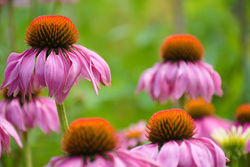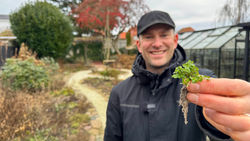How to grow bee balm (Monarda)
- Lars Wildes
- Jan 27, 2023
- 7 min read
Updated: Feb 3, 2023
One of my favorite perennials is bee balm. Loved for its bright, vibrant flowers and long bloom season, bee balm is a beautiful addition to any garden — especially to gardens that want to attract more pollinators.
Bee balm is also known as Monarda. It's a native North American wildflower that comes in a variety of colors, including red, pink, lavender, purple, and white.
My father-in-law plants it around his blueberry fields in Alma, Georgia, to attract bees and other pollinating insects to the blueberry blooms. So it’s not just pretty to look at, it’s a major player in agriculture, too.
When it comes to planting bee balm, it's best to do so in the spring or fall. Bee balm plants are fast-growing perennials that often reach full height and flowering maturity in their first season.
If you’re looking to add bee balm to your border or garden, just remember that it’s part of the mint family and can spread quite aggressively, so it's best to keep an eye on it if you don't want it to take over your garden.
But the effort is worth it. Not only will hummingbirds, bees and butterflies love the nectar, but bee balm also makes a tasty tea or garnish, and smells just as delicious.
I’m breaking down the most often-asked questions about bee balm below to help you grow and care for it in your garden.

Is bee balm a perennial, annual or biennial?
Bee balm is a perennial plant.
Monarda usually lives for more than 2 years and returns each season from its root system. Like other perennials, bee balm will die back to the ground at the end of the growing season and reemerge from the roots the following spring.
What is bee balm good for?
Bee balm has flowers with a sweet citrusy scent reminiscent of a bergamot orange.
The leaves and flowers of the plant can be used to make tea, which is reported to have medicinal properties including helping with digestive issues, such as indigestion, gas and bloating.
When using the leaves and flowers for making bee balm tea, it's best to dry them first by spreading them out on a paper towel in a well-ventilated area, away from direct sunlight. Once they’re dry, you can store them in an airtight container for later use.
The tea can also be used as a mouthwash to help relieve sore throats and mouth infections.
The plant also has antiseptic and antifungal properties, which makes it helpful for skin conditions such as eczema and acne.
And (my favorite), it’s an incredible choice for gardeners because it attracts bees, butterflies, and hummingbirds.

Where does bee balm grow best?
Bee balm is native to North America, but it can grow in most areas with moderate to high humidity, and well-draining soil. It's a hardy plant that can tolerate some drought, but grows best with regular watering and fertilization.
Monarda plants prefer full sun to partial shade, but can tolerate some shade.
Bee balm grows in a variety of soil types, but prefers rich, moist soils that are slightly acidic to neutral (pH 6.0-7.0).
In the USA, it grows in hardiness zones 4 to 9. And here in Denmark, it grows beautifully, too.
Bee balm can be propagated by seed, dividing existing root clumps, or with cuttings.
When does bee balm bloom?
You’ll enjoy bee balm in full bloom in June and July.
The flowers come in 2-3” wide flower heads and come in white, pink, red, and purple.

Why is it called bee balm?
This is a great question. And one I had to look up myself.
Bee balm got its name because it’s a favorite among bees and other pollinators.
The plant produces brightly colored, tubular flowers that are rich in nectar, making it a popular source of food for bees and other insects. Ergo the name bee balm — like a balm for bees.
The flowers also give off a strong, sweet aroma that attracts bees and other pollinators from miles around.
The plant's genus name, Monarda, is from the 16th century Spanish physician and botanist, Nicolás Monardes, who wrote about medicinal plants of the New World (now the Americas). Then, the plant was used by Native Americans for medicinal purposes.
When do you plant bee balm?
The best time to plant bee balm depends on your local climate and the type of planting you’re doing.
For most areas, it's best to plant bee balm in the spring or fall, when the weather is mild.
If you're planting bee balm as a perennial, plant it in the spring, after the last frost date in your area. This will give the plant plenty of time to establish itself before the hot summer months arrive.
If you're planting bee balm from seed, start them indoors 6-8 weeks before the last frost date, then transplant them outside after all danger of frost has passed.
If you're planting bee balm in the fall, do so a few weeks before the first frost date in your area. This gives the plant enough time to establish itself before the ground freezes.
When planting bee balm, keep in mind that the plant prefers well-drained soil, and full sun to partial shade, but it can tolerate some shade.

How tall does bee balm grow?
Bee balm can grow up to 4 feet tall (121 cm) with a spread of 3-4 feet (91-121 cm).
How do you plant bee balm?
Bee balm is quite easy to plant. Here are the basic steps to plant one in your garden.
Choose a location. Bee balm prefers full sun to partial shade and well-drained soil that is slightly acidic to neutral (pH 6.0-7.0).
Prepare the soil. Before planting, work the soil to a depth of about 12 inches (30 cm). If the soil is heavy clay or sandy, add organic matter such as compost or peat moss to improve drainage and fertility.
Plant the seedlings or divisions. Space your bee balm seedlings or divisions about 18 to 24 inches apart (45-60 cm). Dig a hole that is about twice as wide as the root ball and just as deep. If you're planting from seed, transplant the seedlings when they are about 3 inches tall (around 7 cm)l.
Water. Water the newly planted bee balm thoroughly, and keep the soil consistently moist for the first few weeks. This is especially important if you’re in a warm climate.
Fertilize. After the first growing season, fertilize your bee balm perennial with a balanced, slow-release fertilizer in the spring.
Prune. After the first blooming, prune your Monarda plant back to encourage bushier growth and prevent it from becoming too tall and leggy.

Should you deadhead bee balm?
Deadheading is the process of removing spent flowers from a plant — to remove the ‘dead’ flowers and allow for new ones to bloom.
The answer is yes, you should deadhead bee balm for several reasons:
Deadheading encourages reblooming — Removing spent flowers from your bee balm plant can encourage the plant to produce more blooms. This is because the plant will focus its energy on producing more flowers instead of going to seed.
Deadheading prevents self-seeding — Removing ‘dead’ flowers from bee balm prevents the plant from self-seeding and possibly overtaking your garden.
Deadheading bee balm improves its appearance — Removing spent flowers improves the overall appearance of the plant, making it look tidier and more attractive.
Deadheading prevents disease — Another great reason to deadhead your bee balm is that removing spent flowers helps prevent fungal diseases such as powdery mildew that can form on the seed heads.
Deadheading bee balm (and this goes for all perennials) is a personal preference, some people like the natural look of the plant and choose not to deadhead it.
How do you deadhead bee balm?
If you decide to deadhead your bee balm, simply pinch or cut off the spent flowers with a pair of scissors or your fingers. It’s best to do this after the flower has finished blooming, but before it goes to seed.
How to divide bee balm?
Bee balm is a very easy plant to divide. With just a shovel or a spade, you’ll quickly have plants to spread around your garden or give to neighbors and friends. The bees will thank you for sharing.
Dig up portions of the plant in the spring right after it appears and cut the clumps apart at the base of the roots.
Make sure each new clump has at least 3-4 new stems and a root system. Plant these new cuttings right away or give them away to friends who want to grow more pollinator-friendly plants.

When can you harvest bee balm?
The best time to harvest bee balm depends on what part of the plant you plan to use — leaves, flowers, or seeds.
Bee balm leaves — The leaves can be harvested at any time during the growing season. However, they are most flavorful and fragrant when the plant is in full bloom.
Bee balm flowers — The flowers can be harvested just as they begin to open, they’re also most flavorful and fragrant when they’re in full bloom.
Bee balm seeds — The seeds of bee balm can be harvested after the flowers have wilted, dried and turned brown. Be sure to not deadhead the plant as you want it to go to seed.
When you harvest bee balm, remember to only take a small portion of the plant at a time, so that the plant can continue to grow and produce more leaves and flowers.
I recommend using scissors or pruning shears to cut the leaves and flowers, rather than pulling them off by hand because this can damage the plant.
What are the main varieties of bee balm?
Here are a few of the most common varieties of bee balm:
Monarda didyma — This type is also known as scarlet bee balm or Oswego tea. It’s also the most popular type available. It gives large, vibrant red or pink flowers on tall spikes and typically grows to 2-4 feet tall (60-121 cm) and 2-3 feet wide (60-90 cm).
Monarda fistulosa — This type is also called wild bergamot. It blooms with pale purple or lavender flowers on more compact spikes. It can grow anywhere between 2-3 feet tall (60-90 cm) and 1-2 feet wide (30-60 cm).
Monarda citriodora — This type is also known as lemon bee balm. It has a distinct lemon scent and produces pale pink or lavender flowers on spikes. It typically grows to 2-3 feet tall (60-90 cm) and 1-2 feet wide (30-60 cm).
Monarda 'Jacob Cline' — This hybrid variety of bee balm produces deep red flowers and is known for its resistance to powdery mildew. It typically grows to 2-3 feet tall (60-90 cm) and 2-3 feet wide (60-90 cm).
Monarda 'Raspberry Wine' — This is another hybrid variety with dark, raspberry-red flowers. It’s also known for its resistance to powdery mildew. It can grow 2-3 feet tall (60-90 cm) and 2-3 feet wide (60-90 cm).

What color flowers does bee balm have?
The most common bee balm varieties have red, pink, lavender, or purple flowers, but there are also varieties that have white flowers.
The color of the flower depends on the variety of bee balm you have. Some varieties have flowers in a single color, while others have a mix of colors on the same plant.
The color of the flowers can also vary within the same variety depending on growing conditions and the amount of sunlight the plant receives.
Despite the color, the bees and butterflies are going to love you for planting bee balm in your garden. Happy planting!





